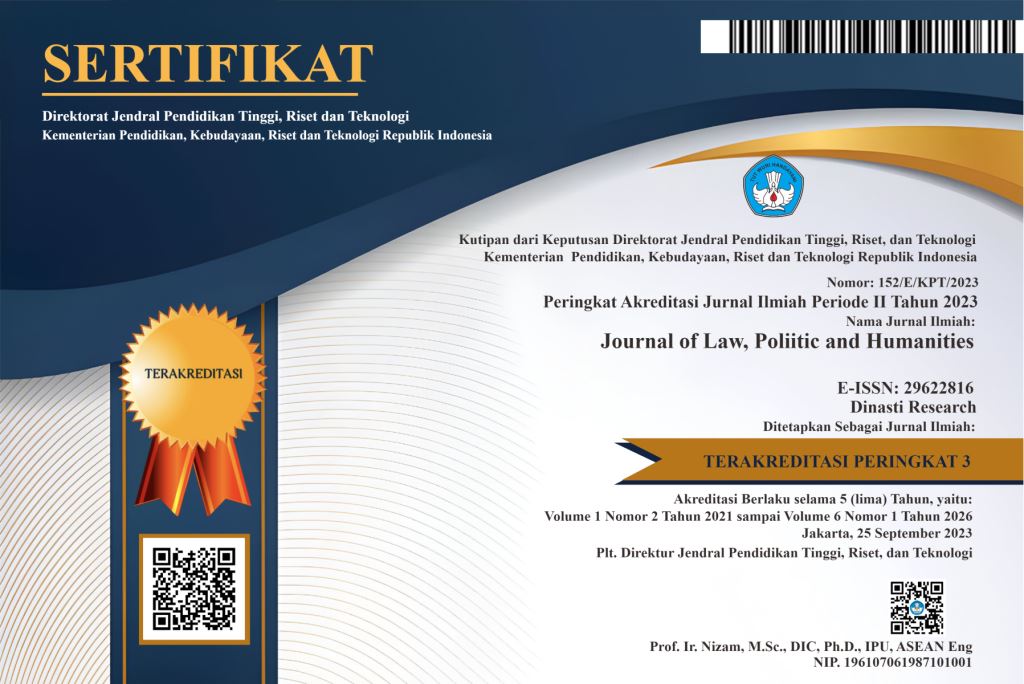Collaborative Policing to Combat Cyber Crime in Banking Sector Modelling – a Systematic Literature Review
DOI:
https://doi.org/10.38035/jlph.v5i5.1952Keywords:
Collaborative Policing, Cybercrime, Banking Industry, Digital ResilienceAbstract
This study addresses the increasing threats of cybercrime that endanger the stability of banking industry, driven by the rapid growth of digital financial transactions. The objective of this research is to formulate a collaborative policing model to effectively prevent and respond to cybercrime within the banking sector. The research was conducted through a comprehensive literature study that explored various aspects of cybersecurity, inter-agency collaboration, technology management, and the roles of actors in cyberspace. The findings indicate that an effective collaborative policing strategy requires the integration of multiple components such as initial conditions, motivation, key actors, emerging technologies, vulnerabilities, international legal frameworks, cyber diplomacy, collaborative processes, and outcome governance. The collaboration process must be built on open dialogue, strong commitment, mutual trust, and shared consensus to create adaptive and sustainable cyber resilience. The conclusion of this study is that a collaborative policing model can serve as a strategic approach to enhance the effectiveness of cybercrime prevention and response efforts in Indonesia’s digital financial sector
References
Aditya, B. I., & Kusumastuti, R. (2023). Collaborative Governance in Police: A Review of Research, Managerial Implication and Agenda for Future Research. Journal La Sociale, 4(5), 250–264. https://doi.org/10.37899/journal-la-sociale.v4i5.891
Ali, G., Mijwil, M. M., Buruga, B. A., & Abotaleb, M. (2024). A Comprehensive Review on Cybersecurity Issues and Their Mitigation Measures in FinTech. Iraqi Journal for Computer Science and Mathematics, 5(3), 45–91. https://doi.org/10.52866/ijcsm.2024.05.03.004
Al-Kumaim, N. H., & Alshamsi, S. K. (2023). Determinants of Cyberattack Prevention in UAE Financial Organizations: Assessing the Mediating Role of Cybersecurity Leadership. Applied Sciences (Switzerland), 13(10). https://doi.org/10.3390/app13105839
Ansell, C., & Gash, A. (2008). Collaborative governance in theory and practice. Journal of Public Administration Research and Theory, 18(4), 543–571. https://doi.org/10.1093/jopart/mum032
Asakpa, S. T., & Chaifetz, R. (2023). From Risk to Resilience: Strengthening Cyber Security in Financial Institutions. In International Journal of Advance Research, Ideas and Innovations in Technology. https://www.ijariit.com
Atkins, S., & Lawson, C. (2021). Cooperation amidst competition: cybersecurity partnership in the US financial services sector. Journal of Cybersecurity, 7(1). https://doi.org/10.1093/cybsec/tyab024
Bada, M., & Nurse, J. R. C. (2021, June 14). Profiling the Cybercriminal: A Systematic Review of Research. 2021 International Conference on Cyber Situational Awareness, Data Analytics and Assessment, CyberSA 2021. https://doi.org/10.1109/CyberSA52016.2021.9478246
Calliess, C., & Baumgarten, A. (2020). Cybersecurity in the EU The Example of the Financial Sector: A Legal Perspective. German Law Journal, 21(6), 1149–1179. https://doi.org/10.1017/glj.2020.67
Despotovi?, A., Parmakovi?, A., & Miljkovi?, M. (2023). Cybercrime and Cyber Security in Fintech (pp. 255–272). https://doi.org/10.1007/978-3-031-23269-5_15
Docherty, K., & Russell, B. (2022). Police Scotland and Local Government Collaborative Leadership Pilots Evaluation. https://www.sipr.ac.uk/projects/targeted-rapid-research-call-evaluation-of-collaborative-leadership-pilots/
Feradinata, I. (2023). Collaborative Policing dalam Era Kontemporer untuk Memperkuat Harkamtibmas. Jurnal Impresi Indonesia, 2(5), 468–477. https://doi.org/10.58344/jii.v2i5.2459
Gerdenitsch, C., Wurhofer, D., & Tscheligi, M. (2023). Working Conditions and Cybersecurity: Time Pressure, Autonomy and Threat Appraisal Shaping Employees’ Security Behavior. Cyberpsychology, 17(4). https://doi.org/10.5817/CP2023-4-7
Gunawan, A. B., Pratama, B., & Sarwono, R. (2021). Digital proxemics approach in cyber space analysis - A systematic literature review. ICIC Express Letters, 15(2), 201–208. https://doi.org/10.24507/icicel.15.02.201
Hapsari, W., & Meliala, A. (2022). Collaborative Policing Model: Strategy for Maintaining Community Security and Order in Disaster Situations. International Journal of Multidisciplinary Research and Analysis, 5(9). https://doi.org/10.47191/ijmra/v5-i9-29
Jesus, V., Bains, B., & Chang, V. (2024). Sharing Is Caring: Hurdles and Prospects of Open, Crowd-Sourced Cyber Threat Intelligence. IEEE Transactions on Engineering Management, 71, 6854–6873. https://doi.org/10.1109/TEM.2023.3279274
Oyeniyi, L. D., Ugochukwu, C. E., & Mhlongo, N. Z. (2024). Developing Cybersecurity Frameworks for Financial Institutions: a Comprehensive Review and Best Practices. Computer Science & IT Research Journal, 5(4), 903–925. https://doi.org/10.51594/csitrj.v5i4.1049
Li, M. (2017). Collaborative Governance and Partnerships in Policing. Open Journal of Social Sciences, 05(12), 50–58. https://doi.org/10.4236/jss.2017.512004
Li, Y., & Liu, Q. (2021). A comprehensive review study of cyber-attacks and cyber security; Emerging trends and recent developments. Energy Reports, 7, 8176–8186. https://doi.org/10.1016/j.egyr.2021.08.126
Lusthaus, J. (2024). Annual Review of Law and Social Science Reconsidering Crime and Technology: What Is This Thing We Call Cybercrime? https://doi.org/10.1146/annurev-lawsocsci-041822
Martineau, M., Spiridon, E., & Aiken, M. (2023). A Comprehensive Framework for Cyber Behavioral Analysis Based on a Systematic Review of Cyber Profiling Literature. In Forensic Sciences (Vol. 3, Issue 3, pp. 452–477). Multidisciplinary Digital Publishing Institute (MDPI). https://doi.org/10.3390/forensicsci3030032
McGregor, R., Reaiche, C., Boyle, S., & Corral de Zubielqui, G. (2024). Cyberspace and Personal Cyber Insurance: A Systematic Review. In Journal of Computer Information Systems (Vol. 64, Issue 1, pp. 157–171). Taylor and Francis Ltd. https://doi.org/10.1080/08874417.2023.2185551
Pajón, L., & Walsh, D. (2023). The importance of multi-agency collaborations during human trafficking criminal investigations. Policing and Society, 33(3), 296–314. https://doi.org/10.1080/10439463.2022.2106984
Papuashvili, D. (2023). Cyber Resilience Implications for the Financial System. Business Administration Research Papers, 8(a). https://doi.org/10.62232/barp.8.2023.6774
Pomerleau, P.-L., & Lowery, D. L. (2020a). Countering Cyber Threats to Financial Institutions. Springer International Publishing. https://doi.org/10.1007/978-3-030-54054-8
Pomerleau, P.-L., & Lowery, D. L. (2020b). The Evolution of Cybersecurity within the American Financial Sector. In Countering Cyber Threats to Financial Institutions (pp. 29–45). Springer International Publishing. https://doi.org/10.1007/978-3-030-54054-8_3
Pratama, B., & Bamatraf, M. (2021). Tallinn manual: Cyber warfare in Indonesian regulation. IOP Conference Series: Earth and Environmental Science, 729(1). https://doi.org/10.1088/1755-1315/729/1/012033
Pugnetti, C., Björck, A., Schönauer, R., & Casián, C. (2024). Towards Diagnosing and Mitigating Behavioral Cyber Risks. Risks, 12(7). https://doi.org/10.3390/risks12070116
Ruijer, E., Van Twist, A., Haaker, T., Tartarin, T., Schuurman, N., Melenhorst, M., & Meijer, A. (2023). Smart Governance Toolbox: A Systematic Literature Review. Smart Cities, 6(2), 878–896. https://doi.org/10.3390/smartcities6020042
Sweetman, A. (2022). Cyber and the City. Springer International Publishing. https://doi.org/10.1007/978-3-031-07933-7
Jooda, T. O., Aghaunor, C. T., Kassie, J. D., & Peter Oyirinnaya. (2023). Strengthening cyber resilience in financial institutions: A strategic approach to threat mitigation and risk management. World Journal of Advanced Research and Reviews, 20(3), 2166–2177. https://doi.org/10.30574/wjarr.2023.20.3.2424
Torfing, J., Sørensen, E., & Breimo, J. P. (2023). When Norway met co-creation: the import, diffusion, and onboarding of a magic concept in public administration. International Public Management Journal, 26(5), 667–686. https://doi.org/10.1080/10967494.2022.2128127
Tridgell, J. (2025). Open or closing doors? The influence of ‘digital sovereignty’ in the EU’s Cybersecurity Strategy on cybersecurity of open-source software. Computer Law & Security Review, 56, 106078. https://doi.org/10.1016/J.CLSR.2024.106078
Weerawardhana, K. G. S. D., & Wijewardhana, B. V. N. (2024). Community-Oriented Policing: A Theoretical Exploration and its Implications for Building Safer Communities. International Journal of Research and Innovation in Social Science, VIII(II), 15–21. https://doi.org/10.47772/IJRISS.2024.802002
Zhao, J. L., Bi, H. H., Chen, H., Zeng, D. D., Lin, C., & Chau, M. (2006). Process-driven collaboration support for intra-agency crime analysis. Decision Support Systems, 41(3), 616–633. https://doi.org/10.1016/j.dss.2004.06.014
Downloads
Published
How to Cite
Issue
Section
License
Copyright (c) 2025 Wani Sabu, Albertus Wahyurudhanto, Puspitasari, Bambang Pratama

This work is licensed under a Creative Commons Attribution 4.0 International License.
Authors who publish their manuscripts in this journal agree to the following conditions:
- The copyright on each article belongs to the author(s).
- The author acknowledges that the Journal of Law, Poliitic and Humanities (JLPH) has the right to be the first to publish with a Creative Commons Attribution 4.0 International license (Attribution 4.0 International (CC BY 4.0).
- Authors can submit articles separately, arrange for the non-exclusive distribution of manuscripts that have been published in this journal into other versions (e.g., sent to the author's institutional repository, publication into books, etc.), by acknowledging that the manuscript has been published for the first time in the Journal of Law, Poliitic and Humanities (JLPH).


























